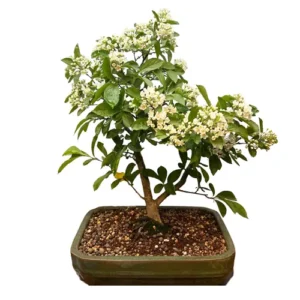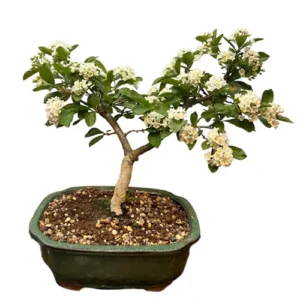Prunus
Cherry Bonsai
Prunus is a colossal genus including numerous highly popular species of bonsai. Rarely seen outside of Japan, Cherrys blossom splendent pink foliage that is as short-lived as it is attention-grabbing. Many trees of age have striking twisted trunks only adding to their aesthetic majesty.
Cherry Bonsai Care Tips
Placement
Cherry Bonsai are hardy species requiring no special winter protection in temperate zones. Across the growing season, all Cherry bonsai can be placed in full sun.
Watering
Throughout the growing season be sure to water regularly, in the summer this is especially important. The petals can be easily damaged by water so be sure to not splash them when watering. Across the winter keep the soil moist.
Feeding & Fertilising
Across the growing period, using a solid organic fertiliser will work once a month or a liquid fertiliser will do the job once a week. If feeding a mature tree avoid fertilisers with high nitrogen content.
Pruning & Wiring
Cherry Bonsai can be a challenging tree to make your desired shape out of. Older branches can be shortened after flowering. Be meticulous in caring for the leaf buds. Trimming new shoots too early can cause die-back, let them grow freely for a period. Next season’s flower buds will only appear towards the end of summer. Long shoots can be shortened in the autumn, leave a couple or so nodes. Pruning larger branches or wiring the tree is best done in the winter or early spring.
Wiring is easiest with no leaves on the tree. Be careful with older branches that have grown brittle or stiff. We recommend using wires that match the branch’s thickness: if the wire you choose is too thick you will damage the bark. If it is too thin, it won’t be effective.
Repotting
Bonsai cherry requires repotting once every two to three years in the early spring before it flowers. An older cherry bonsai will require potting less often. Take care when cutting the roots of an older bonsai tree, these need treating more gently and considerately than a younger specimen.
Trees that are ready for repotting will require root pruning, a suitable new pot and appropriate soil mix.
When repotting, do not cut back the root mass by a large amount, and choose a well-draining soil mix that has a neutral or slightly higher PH value of 5-6 but not over 7. We tend to use a mixture of different speciality bonsai soils on our trees. Every species is different so please contact us for free soil-mix advice or to take advantage of our repotting service.
Bonsai trees aren’t only magnificent additions to an indoor oasis, they are more than capable of standing out in any garden. Many Bonsai species are incredibly hardy and withstand nature’s colder and damper turns with aplomb making them worthwhile outdoor plants. We have an extensive library of care guides for outdoor bonsai trees. It’s not about selecting the perfect bonsai, it’s about selecting the perfect bonsai for you.
Cherry Bonsai - Typical Queries
How to propagate a Cherry Bonsai?
This species of bonsai can propagated with cuttings, seed or air-layering. Spring is the time to take hardwood cuttings, ideally before the buds bloom. Take semi-hardwood cuttings in the summer.
Are Cherry Bonsai prone to pests and diseases?
Prunus is susceptible to an array of diseases and pests. Powdery mildew, leaf spot, rust, crown and root rot and verticillium wilt are all fungal disease potentials for Prunus species. Bacterial diseases like black knot and canker can also occur. Rasp leaf is a virus-specific for Cherry bonsai. Pests including mealy buds, gall mites, caterpillars, scale, spider mites and aphids will need pesticides to address them.
When does Cherry Bonsai bloom?
Typically, Cherry Bonsai bloom across March and April. Fruiting species Prunus avium and Prunus cersasus will start to bear its fruit around this time.





















